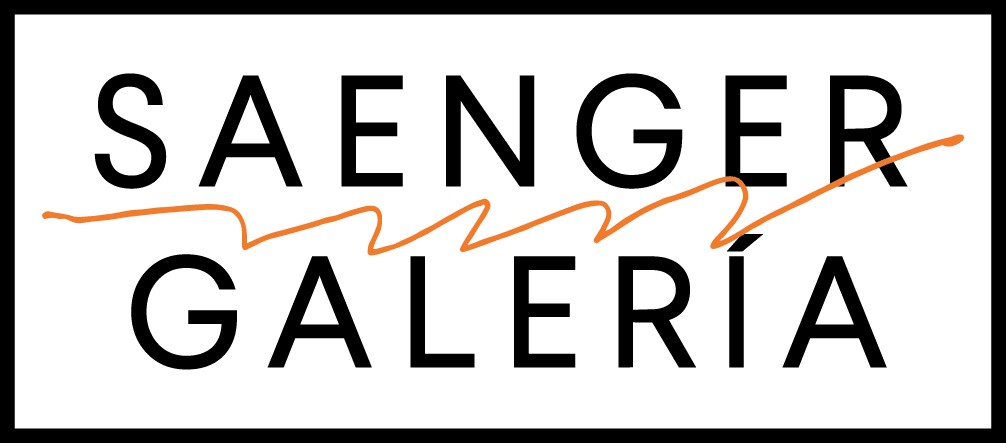Tied to the mast: Curated by Eduardo Luque
Tied to the mast: a phrase meaning to continue on a course of action even when facing great difficulties or likely disaster.
These paintings, like Brutalist architecture, explore elemental geometric forms, monochromatic palettes, and modular elements, yet depart from Brutalism with their many references to the body, biology, the abject, and the inchoate. To make these paintings I draw from a library of silicone molds. Molds of elaborately folded paper pieces as well as many found objects: consumer packaging, camping pads, and more poetic or fantastical objects like meteorites and mammoth teeth. These silicone molds, or three-dimensional negative images of the intended shape, are painted in with layer after layer of acrylic paint, which dries into solid casts. I use paint as a casting medium. It is the sculptural materialization of solid color, unmooring it from both canvas and stretcher. And like Brutalism cast concrete the result is the honest expression of materials as well as the production of self-reflexive solid paint objects whose repetitive casting is mirrored in their repetitive shapes, facets, and patterns. The use of molds results in the creation of works that are both gestural yet serialized, discreet yet continuous, linear and cyclic, autonomous yet something a part of a totality that is forever “in potential”.
— Mark Hagen
__________________________________________
Saenger Galería is pleased to present the latest exhibition by Los Angeles-based artist Mark Hagen, Tied to the Mast, at Casa Limantour in Mexico City, curated by Eduardo Luque. The exhibition features a new series of works that interrogate the boundaries between architecture, painting, and sculpture, while drawing inspiration from Mexican brutalist architecture, Yona Friedman’s vision of L’Architecture Mobile, and the myth of Odysseus.
At the core of the exhibition is Hagen’s reconfigurable, DIY spatial frame structure, known in this iteration as "El Mástil," which serves both as a support system for his paintings and a conceptual reference to Yona Friedman’s radical idea of flexible, democratized architecture controlled by its inhabitants.
Friedman’s L’Architecture Mobile envisioned a future where residents could customize, dismantle, and reconfigure the built environment to suit their changing needs, prioritizing human freedom over rigid, permanent structures. Hagen’s spatial frame installations attempt to revive this aspirational history, offering a non-hierarchical and flexible alternative to traditional art exhibition design. Approaching architectural and monumental dimensions, they suggest an alternative to the exhibition space itself, while standing in opposition to both architectural and monumental forms that typically venerate power, hierarchy, and the desire for permanence. Ultimately, Hagen seeks to reclaim the spatial frame from its industrial and corporate associations, transforming it into a symbol of democratized, collective architecture—a perhaps necessary option in light of growing economic inequality and environmental catastrophe.
The exhibition title, Atado al Mástil, references the myth of Odysseus, whose crew tied him to the mast of his ship to resist the seductive song of the sirens. This "Ulysses Pact," designed to bind oneself in the future to a past decision, raises questions about trust, autonomy, and the tension between present conventions and desires. Hagen’s paintings, tethered to his spatial "Mástil," embody this tension, exploring themes of restriction, freedom, and the paradoxical nature of the human experience.
The paintings themselves represent a radical break from traditional methods. Here, Hagen uses painting as a molding medium, layering acrylic onto silicone molds made from folded paper, consumer packaging, camping mats, and more poetic or fantastical objects like meteorites and mammoth teeth. The result is the production of self-reflective objects, whose repeated molding process is mirrored in their shapes, facets, and repetitive patterns. These solid, cast paintings, freed from the canvas and stretcher, are cut and collaged to form works that blur the line between painting and sculpture. Like the molded concrete of brutalism, often criticized for its supposed coldness but also praised for its “honesty” and raw expression of materials, these paintings explore geometric forms, monochromatic palettes, and modular elements. However, they diverge from brutalism with numerous references to the body, biology, the abject, and the inchoate.
“I am interested in creating paintings that are both gestural and serialized, discrete yet continuous, autonomous but part of a whole that is always in potential,” says Hagen. “This body of work challenges both architecture and painting to be more flexible and dynamic, reflecting the fluidity of human experience and an unrealized potential for the built environment.”
_______________________________________________
This exhibition is inspired by the story of Odysseus and his crew encountering the sirens, whose song lures sailors to their deaths. To survive, Odysseus has his crew tie him to the mast of the ship while he blocks his ears with beeswax. A "Ulysses Pact" is designed with the purpose of binding one's future self to a past decision. The term is used in medicine, especially in reference to “advance directives,” also known as living wills. It raises the questions: Do we trust our past self? Do we trust the mast?
As the artist refers, these paintings, like brutalist architecture, explore elemental geometric elements: shapes, monochromatic palettes, and modular components that, however, deviate from brutalism due to their multiple references to the body and biology.
The exhibition shows us the relationship and honest repetition of materials, their shapes and patterns, both the canvas and the stretcher, and the production of self-reflective solid painting objects. The constant evolution of past works and new ones. The ongoing questioning of potential, continuity, and the relationship with the built environment. Of the alliance and intensity of materials, color, form, and structure.
The premonition of what the next piece will be.
The material supports are intended to suggest and contain the background of the piece, freeing the “being tied” from figuration, thus ending the idea of the image as a limitation of appearances. Mark Hagen’s works absorb the gaze through their character and organic pursuit.
— Eduardo Luque
Ph. Aimée Suarez



